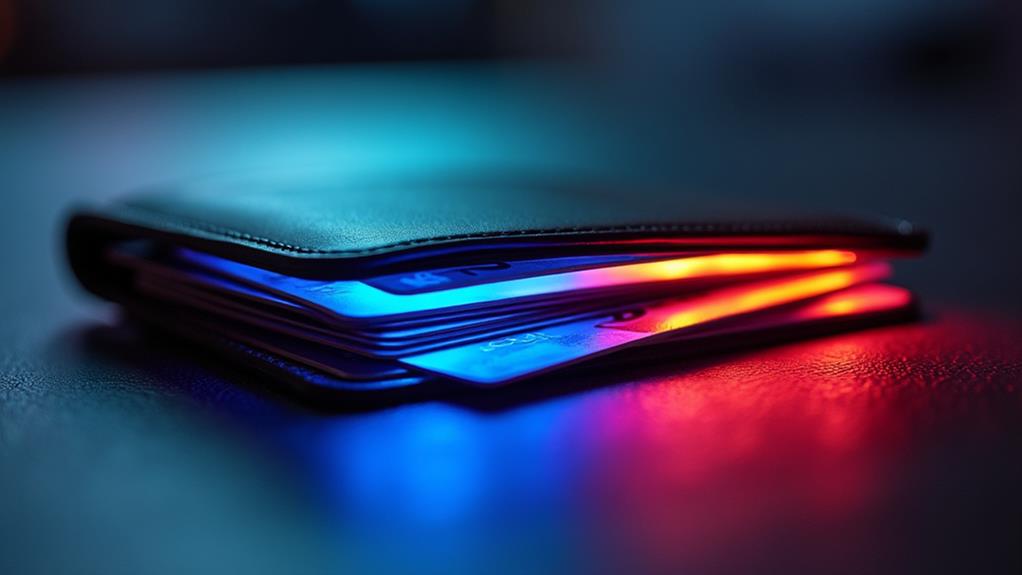LED Credit Cards That Light Up Your Wallet
LED credit cards that light up your wallet are a statement piece that combines advanced technology and sleek design. I’m intrigued by how they work – powered by inductive chargers and contactless terminals, they illuminate during transactions, enhancing user experience and financial management convenience. They offer real-time spending updates, instant rewards notifications, and immediate fraud alerts. If you’re curious about how these futuristic cards could transform your daily transactions, you might be surprised at what you discover.
Key Takeaways
LED credit cards offer a unique user experience with dynamic displays, real-time updates, and instant rewards notifications.
These cards utilize printed LED lamps powered by inductive chargers and contactless terminals, lighting up during transactions.
LED cards enhance security with EMV chip technology, two-factor authentication, and battery-free operation through NFC fields.
Despite their innovative design, LED cards have environmental implications, including the use of rare metals and plastics, and disposal issues.
Sustainable alternatives to LED cards include virtual cards and those made from recycled materials, reducing electronic waste concerns.
Benefits of LED Credit Cards
LED credit cards, while not a traditional credit card type, offer a unique selling point with their advanced technology and sleek look. I find them particularly appealing because they provide benefits that traditional credit cards don’t. For instance, they can light up, making them easier to find in my wallet at night. Additionally, their digital displays can show my balance and transaction history, keeping me updated on my spending. These features enhance my user experience and make managing my finances more convenient. Overall, the benefits of LED credit cards make them an attractive option for those looking for a modern and innovative payment solution.
How LED Credit Cards Work
The innovative technology behind these modern credit cards relies on a printed LED lamp with an antenna that can be powered by various devices, including inductive phone chargers and contactless payment terminals. This feature allows the card to light up during transactions, creating a unique user experience. I can power my LED credit card using Qi chargers, POS terminals, or even my smartphone’s NFC field. This versatility guarantees that my card remains functional and visually appealing. The integration of light into the card’s design not only enhances aesthetics but also adds a security dimension by validating transactions and authenticating identity. This blend of functionality and visual appeal makes LED credit cards a standout in the financial industry.
Enhancing User Engagement
As I use my LED credit card, I notice how its innovative technology enhances my overall experience. The card’s dynamic display provides real-time updates on my spending and rewards, making it easier for me to track my finances. Here’s how it enhances user engagement:
| Feature | Description |
|---|---|
| Dynamic Display | Real-time spending updates |
| Rewards Tracking | Instant rewards notifications |
| Security Alerts | Immediate fraud alerts |
| Personalization | Customizable card face |
| Interactive Feedback | Instant transaction feedback |
Security Features of LED Cards
Between the convenience of contactless payments and the visual appeal of dynamic displays, I find that security features are an essential aspect of LED credit cards. These cards, such as the IDEMIA Starlight card, are designed with advanced security measures like EMV chip technology and two-factor authentication. The use of OLED technology allows for battery-free operation, powered by the NFC field when near a POS reader. This guarantees a secure and contactless payment experience. Additionally, the cards are certified by major payment schemes like Mastercard and Visa, guaranteeing compliance with international standards. These security features provide peace of mind, making LED credit cards not just visually appealing but also secure and reliable for transactions.
The Future of Digital Payments
Someone might ask, what’s next for digital payments? As we embrace contactless and mobile payments, the future of digital payments looks promising. With advancements in technology, we can expect more innovative payment solutions. Here are some potential developments:
- Biometric Payments: The use of biometrics such as fingerprints, facial recognition, and voice recognition for secure and convenient transactions.
- Internet of Things (IoT): Integration of payment capabilities into everyday devices, enabling seamless transactions without traditional credit cards.
- Artificial Intelligence (AI): Enhanced fraud detection and personalized payment experiences through AI-driven algorithms.
- Blockchain: Secure and transparent payment processing through blockchain technology, potentially reducing transaction costs and improving security.
Comparing LED Cards to Traditional Cards
When comparing LED credit cards to traditional cards, it’s crucial to take into account both the design and functionality. LED credit cards offer a unique blend of traditional card functionality with modern, innovative features.
| Feature | Traditional Cards | LED Cards |
|---|---|---|
| Material | Paper, plastic | Metal, flashing LED lights |
| Security | Chip or magnetic swipe technology | Enhanced with unique card designs and encryption |
| Design | Plain and functional | Customizable with various design elements |
LED cards combine the reliability of traditional cards with the appeal of modern technology, such as flashing LED lights. These cards are not just about aesthetics; they also enhance security and user experience.
Environmental Impact of LED Cards
Evaluating the environmental impact of LED credit cards requires examining both the production and disposal phases. While they offer a unique aesthetic, their environmental footprint is significant. The production of LED cards involves extensive supply chains and transportation networks, contributing to carbon emissions and waste. Furthermore, the materials used, such as metals and plastics, are not always sourced sustainably.
Some key points to examine:
- Material Extraction: LED cards often contain rare metals and plastics, the extraction and processing of which can have harmful environmental effects.
- Energy Consumption: The production and use of LED cards consume energy, contributing to greenhouse gas emissions.
- Disposal: LED cards are typically not recyclable, leading to electronic waste.
- Sustainable Alternatives: Opting for virtual credit cards or those made from recycled materials can help mitigate these impacts.
Integrating LED Cards Into Daily Life
As we consider integrating LED cards into our daily lives, it is crucial to weigh their convenience against their environmental implications. On one hand, LED cards offer a unique and engaging payment experience, especially with innovative designs like IDEMIA’s Starlight cards that light up during contactless transactions. However, we must also consider the broader environmental impacts of these cards, including their production footprint, energy consumption during use, and potential contribution to electronic waste. To mitigate these effects, opting for eco-friendly cards made from recycled or biodegradable materials and using digital wallets for transactions can be more environmentally friendly alternatives. By making informed choices, we can enjoy the benefits of LED cards while minimizing their environmental footprint.
Conclusion
LED credit cards that light up are revolutionizing payments. These cards operate without a battery, using NFC fields from POS readers to power LED or OLED panels. This innovative design not only enhances user engagement but also adds a layer of security through visual validation of transactions. While digital wallets are on the rise, these cards offer a unique blend of style and functionality, making them stand out in your wallet.









